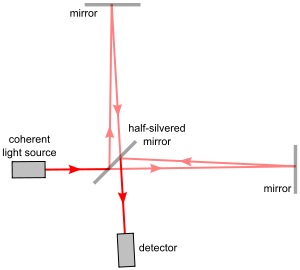
Self-mixing interferometry
Encyclopedia
Self-mixing interferometry is a measurement technique, in which a laser
beam is reflected
from an object, back into the laser. The reflected light interferes
with the light generated inside the laser, and this causes changes in the optical and electrical properties of the laser. Information about the target object and the laser itself can be obtained by analysing these changes in behaviour. The technique is also known as feedback interferometry or induced-modulation interferometry.
 Laser interferometry
Laser interferometry
techniques are widely-used in a range of sensing applications, including the measurement of vibration, displacement and velocity of objects. These methods involve the mixing (or superposition
) of coherent
light waves. Typically, the light from a laser is split into two. Each beam follows a different path before being recombined. A detector is then used to measure the intensity of the light. The Michelson interferometer
and Mach-Zehnder interferometer
s are examples of such systems.
Laser
A laser is a device that emits light through a process of optical amplification based on the stimulated emission of photons. The term "laser" originated as an acronym for Light Amplification by Stimulated Emission of Radiation...
beam is reflected
Reflection
Reflection or reflection may refer to:-Science:* Mirror image, a reflection in a mirror or in water* Reflection nebula, a nebula that is extended and has no boundaries* Reflection , a common wave phenomenon...
from an object, back into the laser. The reflected light interferes
Interference
In physics, interference is a phenomenon in which two waves superpose to form a resultant wave of greater or lower amplitude. Interference usually refers to the interaction of waves that are correlated or coherent with each other, either because they come from the same source or because they have...
with the light generated inside the laser, and this causes changes in the optical and electrical properties of the laser. Information about the target object and the laser itself can be obtained by analysing these changes in behaviour. The technique is also known as feedback interferometry or induced-modulation interferometry.
Background

Interferometry
Interferometry refers to a family of techniques in which electromagnetic waves are superimposed in order to extract information about the waves. An instrument used to interfere waves is called an interferometer. Interferometry is an important investigative technique in the fields of astronomy,...
techniques are widely-used in a range of sensing applications, including the measurement of vibration, displacement and velocity of objects. These methods involve the mixing (or superposition
Superposition principle
In physics and systems theory, the superposition principle , also known as superposition property, states that, for all linear systems, the net response at a given place and time caused by two or more stimuli is the sum of the responses which would have been caused by each stimulus individually...
) of coherent
Coherence (physics)
In physics, coherence is a property of waves that enables stationary interference. More generally, coherence describes all properties of the correlation between physical quantities of a wave....
light waves. Typically, the light from a laser is split into two. Each beam follows a different path before being recombined. A detector is then used to measure the intensity of the light. The Michelson interferometer
Michelson interferometer
The Michelson interferometer is the most common configuration for optical interferometry and was invented by Albert Abraham Michelson. An interference pattern is produced by splitting a beam of light into two paths, bouncing the beams back and recombining them...
and Mach-Zehnder interferometer
Mach-Zehnder interferometer
The Mach–Zehnder interferometer is a device used to determine the relative phase shift between two collimated beams from a coherent light source. The interferometer has been used, amongst other things, to measure small phase shifts in one of the two beams caused by a small sample or the change in...
s are examples of such systems.

